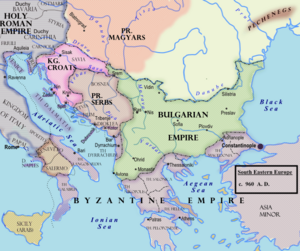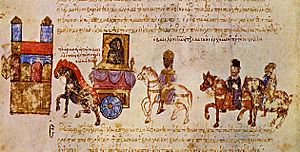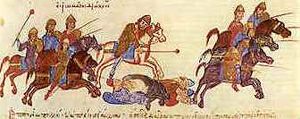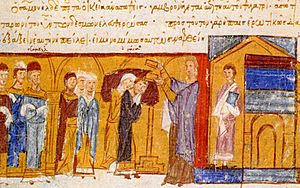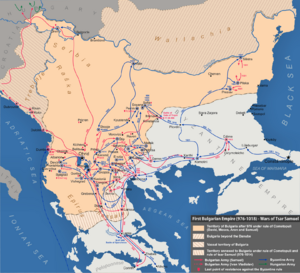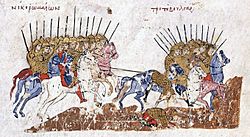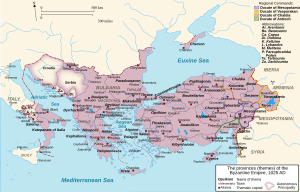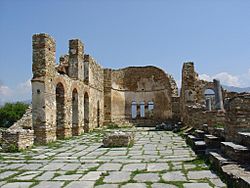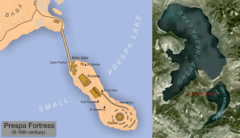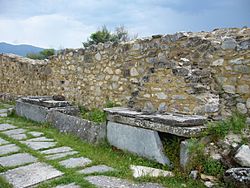Samuel of Bulgaria facts for kids
Quick facts for kids Samuel |
|
|---|---|
| Tsar of Bulgaria | |
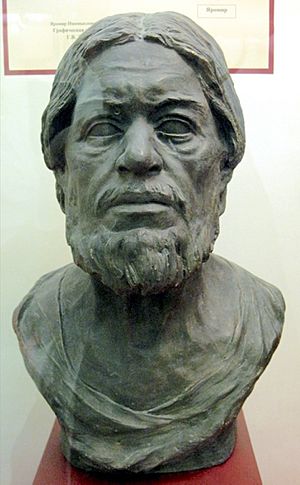
Facial reconstruction based on his remains
|
|
| Reign | 997 – 6 October 1014 |
| Predecessor | Roman |
| Successor | Gavril Radomir |
| Died | 6 October 1014 Prespa, First Bulgarian Empire |
| Spouse | Agatha |
| Issue | Gavril Radomir Miroslava |
| Dynasty | Cometopuli |
| Father | Nicholas |
| Mother | Ripsimia of Armenia |
| Religion | Bulgarian Orthodox |
Samuel (also Samuil; Bulgarian: Самуил; Macedonian: Самоил/Самуил; died October 6, 1014) was the Tsar (which means Emperor) of the First Bulgarian Empire from 997 to 1014. Before that, from 977 to 997, he was a top general under Emperor Roman I of Bulgaria. Roman gave him control of the army and most of the royal power. Samuel worked hard to keep his country independent from the powerful Byzantine Empire. His time as ruler was filled with constant wars against the Byzantines and their ambitious leader, Basil II.
In his early years, Samuel won many important battles against the Byzantines. He even attacked their lands. In the late 900s, Bulgarian armies took over the Serb area of Duklja. They also fought against the Kingdoms of Croatia and Hungary. But after 1001, Samuel mostly had to defend Bulgaria from the stronger Byzantine armies. Samuel died from a heart attack on October 6, 1014. This was two months after the terrible battle of Kleidion. His successors could not keep up the fight. In 1018, four years after Samuel's death, Bulgaria gave up. This ended 50 years of fighting between the Byzantines and Bulgarians.
People thought Samuel was "unbeatable in power and strength." Even in Constantinople, the Byzantine capital, a poet named John Kyriotes wrote a poem comparing him to Halley's comet. During Samuel's rule, Bulgaria controlled most of the Balkans, reaching as far south as Greece. He moved the capital from Skopje to Ohrid. Ohrid had been a key cultural and military city since the time of Boris I of Bulgaria. Samuel made Ohrid the center of the Bulgarian Patriarchate. Because of this, his kingdom is sometimes called the Western Bulgarian Empire. Samuel's strong leadership brought back Bulgaria's power in the Balkans. However, the Empire fell apart after he died.
Contents
The Rise of the Cometopuli Family
Who Were the Cometopuli?
Samuel was the fourth and youngest son of Count Nicholas. Nicholas was a Bulgarian noble. He might have been the count of the Sredets district (modern-day Sofia). Other sources say he was a count in the Prespa district in Macedonia. Samuel's mother was Rhipsime of Armenia. We don't know the real name of their family. Cometopuli was a nickname used by Byzantine historians. It means "sons of the count." The Cometopuli family became powerful during a time of trouble in the Bulgarian Empire, from 966 to 971.
Rus' Invasion and Boris II
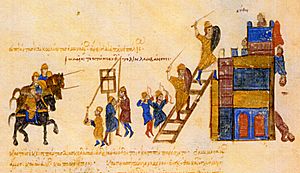
During the rule of Emperor Peter I, Bulgaria had a long period of peace with Byzantium. This peace was secured when Peter married the Byzantine princess Maria Lakapina. She was the granddaughter of Byzantine Emperor Romanos I Lekapenos. But after Maria died in 963, the peace was shaken. Peter I sent his sons, Boris and Roman, to Constantinople. They were honorary hostages to keep the peace treaty. During these years, the Byzantines and Bulgarians fought against Kievan Rus' Prince Sviatoslav. Sviatoslav invaded Bulgaria several times. After a defeat by Sviatoslav, Peter I became ill. He gave up his throne in 969. Boris was allowed to return to Bulgaria to become emperor. He was supposed to restore order and fight Sviatoslav, but he didn't have much success. Nicholas and his sons may have used this as a chance to rebel in 969.
The Rus' invaded Byzantine Thrace in 970. They were defeated in the Battle of Arcadiopolis. The new Byzantine Emperor John Tzimiskes used this to his advantage. He quickly invaded Bulgaria the next year. He defeated the Rus' and captured the Bulgarian capital, Preslav. Boris II of Bulgaria was publicly stripped of his royal symbols in Constantinople. He and his brother Roman remained prisoners. Even though the Byzantines wanted to end the Bulgarian Empire in 971, they couldn't control the western parts of Bulgaria. Count Nicholas, Samuel's father, died in 970. He had been close to the royal court in Preslav. In the same year, "the sons of the count" (the Cometopuli) — David, Moses, Aaron, and Samuel — rebelled. The exact order of events is unclear. But it is certain that after 971, Samuel and his brothers were the real rulers of western Bulgaria.
In 973, the Cometopuli sent messengers to the Holy Roman Emperor Otto I in Quedlinburg. They wanted to protect their lands. The brothers ruled together, sharing power. David ruled the southern regions. He defended the dangerous border areas near Thessaloniki and Thessaly. His main bases were Prespa and Kastoria. Moses ruled from Strumitsa. This was a good place to launch attacks on the Aegean coast and Serres. Aaron ruled from Sredets. He was to defend the main road from Adrianople to Belgrade. He also attacked Thrace. Samuel ruled northwestern Bulgaria from the strong fortress of Vidin. He also planned to free the lands in the east, including the old capital Preslav. Some records suggest that David played a very important role during this time.
War with Byzantium
After John I Tzimiskes died on January 11, 976, the Cometopuli attacked along the entire border. However, within a few weeks, David was killed by wandering Vlachs. Moses was badly hurt during the siege of Serres and died. The brothers' actions in the south kept many Byzantine troops busy. This made it easier for Samuel to free northeastern Bulgaria. A local Bulgarian uprising started there. It was led by two nobles, Petar and Boyan. They became allies of the Cometopuli and joined their rule. The Byzantine army was defeated and went back to Crimea. Any Bulgarian nobles who had not fought against the Byzantine takeover were executed. The war continued north of the Danube River until the enemy was scattered. Bulgarian rule was then restored.
After these defeats in the Balkans, the Byzantine Empire had its own civil war. A commander named Bardas Scleros rebelled in Asia Minor. He sent troops to attack Constantinople. The new Emperor Basil II didn't have enough soldiers to fight both the Bulgarians and the rebels. So, he tried to use tricks and secret plans. Basil II made many promises to the Bulgarians and Scleros. He wanted to stop them from working together against him. Aaron, the oldest living Cometopulus, was tempted to make an alliance with the Byzantines. He wanted to take power in Bulgaria for himself. He owned land in Thrace, which was close to the Byzantine threat. Basil made a deal with Aaron. Aaron asked to marry Basil's sister to seal the deal. But Basil sent the wife of one of his officials instead. The trick was discovered, and the official's wife was killed. Still, talks continued and a peace agreement was made. The historian Scylitzes wrote that Aaron wanted all the power. He "sympathized with the Romans" (Byzantines). Samuel found out about the plan. A fight between the two brothers was unavoidable. The quarrel happened near Dupnitsa on June 14, 976. It ended with Aaron's family being killed. Only his son, Ivan Vladislav, survived. Samuel's son Gavril Radomir begged for his life. From that moment on, Samuel held almost all the power in the state. The danger of an internal conflict was gone.
However, another idea suggests that Aaron fought in the battle of the Gates of Trajan ten years later. According to that idea, Aaron was killed on June 14, 987 or 988.
Ruling with Roman
The Byzantines tried to use Aaron to cause trouble in Bulgaria, but it failed. So, they tried to get the rightful heirs to the throne, Boris II and Roman, to fight Samuel. Basil II hoped they would get support from the nobles. This would isolate Samuel or even start a Bulgarian civil war. Boris and Roman were sent back in 977. But as they walked through a forest near the border, Boris was killed by Bulgarian guards. They mistook him for a Byzantine because of his clothes. Roman, who was walking behind, managed to tell the guards who he was.
Roman was taken to Vidin. There, he was declared Emperor of Bulgaria. Samuel became his main helper and general. Together, they gathered an army and fought the Byzantines. The new emperor gave Samuel control of the government. Roman focused on church and religious matters.
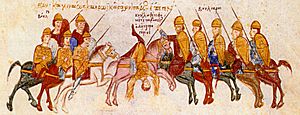
Basil II was busy fighting a rebel named Skleros. Samuel's armies used this chance to attack the Byzantine Empire's lands in Europe. Samuel invaded not only Thrace and the area of Thessaloniki, but also Thessaly, Hellas, and the Peloponnese. Many Byzantine fortresses fell to the Bulgarians. Samuel wanted to capture the important fortress of Larissa. It controlled key routes in Thessaly. From 977 to 983, the town was surrounded. When hunger forced the Byzantines to give up, the people were moved to Bulgaria. The men were forced to join the Bulgarian army. Basil II sent forces to the region, but they were defeated. With this victory, Bulgaria gained influence over most of the southwestern Balkans. However, it didn't fully control all these areas. From Larissa, Samuel took the holy items of Saint Achilleios. These were placed in a special church on an island in Lake Prespa.
The Bulgarian successes in the west worried Constantinople. After much preparation, Basil II launched a campaign into the heart of the Bulgarian Empire. He wanted to pull Samuel away from southern Greece. The Byzantine army went through the mountains near Ihtiman. They surrounded Sredets in 986. The Byzantines attacked the city for 20 days. But their attacks failed and cost them many soldiers. The Bulgarians came out of the city several times. They killed many enemy soldiers and captured animals and horses. Eventually, the Bulgarian troops burned the Byzantine army's siege equipment. This forced Basil II to retreat to Thrace. But on August 17, 986, as they passed through the mountains, the Byzantine army was ambushed. They were completely defeated at the Trajan's Gates Pass. This was a big blow for Basil. He was one of the few to return to Constantinople. His personal treasure was captured by the Bulgarians.
After this defeat, another civil war started in the Byzantine Empire. Bardas Phocas rebelled. Samuel used this chance to put pressure on Thessaloniki. Basil II sent a large army there. He appointed a new governor, Gregorios Taronites. But Gregorios couldn't stop the Bulgarian advance. By 989, Bulgarian troops had gone deep into Byzantine territory. They captured many fortresses, including important cities like Veria and Servia. In the south, the Bulgarians marched through Epirus. In the west, they captured the area of modern Durrës on the Adriatic Sea.
In 989, Phocas was killed, and his followers surrendered. The next year, Basil II made a deal with Skleros. The Byzantines then focused on Bulgaria. They counter-attacked in 991. The Bulgarian army was defeated, and Roman was captured. Samuel managed to escape. The Byzantines took over some areas. However, in 995, the Arabs invaded Asia Minor. Basil II had to move many of his troops to fight this new threat. Samuel quickly took back the lost lands and moved south. In 996, he defeated the Byzantines in the battle of Thessaloniki. During the battle, Thessaloniki's governor, Gregorios, died. His son Ashot was captured. Happy with this success, the Bulgarians continued south. They marched through Thessaly, passed the defensive wall at Thermopylae, and entered the Peloponnese. They destroyed everything in their path.
In response, a Byzantine army led by Nikephorus Uranos was sent after the Bulgarians. The Bulgarians turned north to meet them. The two armies met near the flooded Spercheios River. The Byzantines found a place to cross. On the night of July 19, 996, they surprised the unprepared Bulgarian army. They completely defeated them in the battle of Spercheios. Samuel's arm was wounded. He barely escaped capture. He and his son supposedly pretended to be dead. After nightfall, they headed for Bulgaria. They walked about 400 kilometers (250 miles) home. Research on Samuel's grave suggests that the bone in his arm healed at a 140° angle, leaving it crippled.
Samuel Becomes Emperor
In 997, Roman died while still a prisoner in Constantinople. This ended the line of rulers started by Krum. Because of the war with Byzantium, it was dangerous to leave the throne empty for long. Samuel was chosen as the new Emperor of Bulgaria. He had been very close to the previous emperor. He was also Roman's long-time military commander. A priest from Duklja also wrote about the event: "At that time, among the Bulgarian people, a man named Samuel rose up. He declared himself emperor. He fought a long war against the Byzantines. He drove them out of all Bulgarian territory. The Byzantines did not dare to come near it."
Constantinople would not recognize the new emperor. The Byzantines believed Boris II's giving up the throne meant the official end of Bulgaria. They saw Samuel as just a rebel. Instead, Samuel sought recognition from the Pope. This would be a serious blow to the Byzantines' power in the Balkans. It would also weaken the influence of the Patriarch of Constantinople. This would benefit both the See of Rome and Bulgaria. Samuel likely received his imperial crown from Pope Gregory V.
Wars Against Serbs and Croats
In 998, Samuel launched a major campaign against Duklja. He wanted to stop Prince Jovan Vladimir from forming an alliance with the Byzantines. When the Bulgarian troops reached Duklja, the Serbian prince and his people went into the mountains. Samuel left part of his army at the foot of the mountains. He led the rest to surround the coastal fortress of Ulcinj. To avoid bloodshed, he asked Jovan Vladimir to surrender. The prince refused. But some Serb nobles offered to help the Bulgarians. When it became clear that fighting more was useless, the Serbs surrendered. Jovan Vladimir was sent away to Samuel's palaces in Prespa.
The Bulgarian troops then went through Dalmatia. They took control of Kotor and traveled to Dubrovnik. They couldn't take Dubrovnik, but they destroyed the villages around it. The Bulgarian army then attacked Croatia. They supported the rebel princes Krešimir III and Gojslav. They advanced northwest to Split, Trogir, and Zadar. Then they went northeast through Bosnia and Raška and returned to Bulgaria. This Croato-Bulgarian War allowed Samuel to place rulers loyal to him in Croatia.
Samuel's relative Kosara fell in love with the captured Jovan Vladimir. They married after Samuel approved. Jovan returned to his lands as a Bulgarian official. His uncle Dragomir, whom Samuel trusted, went with him. Meanwhile, Princess Miroslava fell in love with the captured Byzantine noble Ashot. He was the son of Gregorios Taronites, the dead governor of Thessaloniki. Samuel agreed to their marriage. He made Ashot governor of Dyrrhachium. Samuel also made an alliance with the Magyars. His oldest son and heir, Gavril Radomir, married the daughter of the Hungarian Grand Prince Géza.
Byzantine Advances
The new millennium (year 1000) marked a change in the Byzantine-Bulgarian war. Basil II had gathered a larger and stronger army than the Bulgarians. He was determined to conquer Bulgaria for good. He moved many experienced soldiers from his eastern campaigns against the Arabs to the Balkans. Samuel was forced to defend his lands instead of attacking.
In 1001, Basil II sent a large army to northern Balkan Mountains. They were led by Theodorokanos and Nikephoros Xiphias. Their goal was to capture the main Bulgarian fortresses there. The Byzantine troops recaptured Preslav and Pliska. This put northeastern Bulgaria back under Byzantine rule. The next year, they attacked from a different direction. They marched through Thessaloniki to take over Thessaly and the southernmost parts of the Bulgarian Empire. The Bulgarian commander of the Veroia fortress, Dobromir, was married to one of Samuel's nieces. But he gave up the fort willingly and joined the Byzantines. The Byzantines also captured the fortress of Kolidron without a fight. Its commander Dimitar Tihon managed to escape with his soldiers and join Samuel. The next town, Servia, was harder to take. Its governor Nikulitsa organized a good defense. They fought until the Byzantines broke through the walls and forced them to surrender. Nikulitsa was taken to Constantinople. He was given a high court title. But he soon escaped and rejoined the Bulgarians. He tried to retake Servia, but the siege failed. He was captured again and imprisoned.
Meanwhile, Basil II's campaign recaptured many towns in Thessaly. He forced the Bulgarian people from the conquered areas to move to the Voleron area. This was between the Mesta and Maritsa rivers. Edessa resisted for weeks. But it was conquered after a long siege. The people were moved to Voleron. Its governor Dragshan was taken to Thessaloniki. There, he was supposed to marry the daughter of a local noble. Dragshan didn't want to marry an enemy. He tried three times to escape to Bulgaria. He was eventually executed.
War with Hungary
The war between Byzantium and Bulgaria became most intense in 1003. That's when Hungary got involved. Since the early 900s, Bulgarian territory had stretched beyond the Carpathian Mountains. It reached the Tisza River and the middle Danube. During Samuel's rule, the governor of these northwestern parts was Duke Ahtum. He was the grandson of Duke Glad, whom the Hungarians had defeated in the 930s. Ahtum had a strong army. He firmly defended the northwestern borders of the Empire. He also built many churches and monasteries. Through these, he spread Christianity in Transylvania.
Gavril Radomir's marriage to the Hungarian ruler's daughter had created friendly relations. But the relationship got worse after Géza's death. The Bulgarians supported Gyula and Koppány as rulers instead of Géza's son Stephen I. Because of this conflict, the marriage between Gavril Radomir and the Hungarian princess was ended. The Hungarians then attacked Ahtum. He had directly supported the people who wanted to be the Hungarian king. Stephen I convinced Hanadin, Ahtum's right-hand man, to help with the attack. When the plan was discovered, Hanadin ran away and joined the Hungarian forces. At the same time, a strong Byzantine army surrounded Vidin, Ahtum's main city. Many soldiers were needed to defend the town. But Ahtum was busy with the war to the north. After several months, he died in battle when his troops were defeated by the Hungarians. As a result of the war, Bulgarian influence northwest of the Danube became much smaller.
More Byzantine Successes
The Byzantines took advantage of Bulgaria's problems in the north. In 1003, Basil II led a large army to Vidin. This was the most important town in northwestern Bulgaria. After an eight-month siege, the Byzantines finally captured the fortress. It was supposedly due to betrayal by the local bishop. The town's commanders had stopped all earlier attempts to break their defenses. This included using Greek fire. While Basil's forces were busy there, Samuel attacked in a different direction. On August 15, he attacked Adrianople and looted the area.
Basil II decided to return to Constantinople afterward. But he feared meeting the Bulgarian army on the main road. So, he used a different route. The Byzantines marched south through the Morava valley. They reached a key Bulgarian city, Skopje, in 1004. The Bulgarian army was camping on the other side of the Vardar River. Basil II found a place to cross the river. He attacked and defeated Samuel's unsuspecting army. He used the same tactics as at Spercheios. The Byzantines continued east and surrounded the fortress of Pernik. Its governor, Krakra, was not tempted by Basil's promises of noble titles and wealth. He successfully defended the fortress. The Byzantines retreated to Thrace after suffering heavy losses.
In the same year, Samuel marched against Thessaloniki. His men ambushed and captured its governor, Ioannes Chaldus. But this success could not make up for the losses the Bulgarians had suffered in the past four years. The setbacks in the war made some of Samuel's military commanders lose hope. This was especially true for the captured Byzantine nobles. Samuel's son-in-law Ashot, the governor of Dyrrhachium, contacted the local Byzantines. He also contacted the influential John Chryselios, Samuel's father-in-law. Ashot and his wife boarded one of the Byzantine ships that were attacking the town. They fled to Constantinople. Meanwhile, Chryselios gave the city to the Byzantine commander Eustathios Daphnomeles in 1005. He secured the title of patrician for his sons.
In 1006–1007, Basil II went deep into Bulgarian-ruled lands. In 1009, Samuel's forces were defeated at Kreta, east of Thessaloniki. In the next years, Basil launched yearly campaigns into Bulgarian territory. He destroyed everything in his path. There was still no single decisive battle. But it was clear that the end of Bulgarian resistance was coming closer. The fierce fighting and constant campaigns by both sides devastated both the Bulgarian and Byzantine lands.
The Disaster at Kleidion
In 1014, Samuel decided to stop Basil before he could invade Bulgaria. The Byzantines usually used the valley of the Strumitsa River for their invasions. So, Samuel built a strong wooden wall in the gorges near the village of Klyuch (also called Kleidion, meaning "key"). This was to block the enemy's way.
When Basil II started his next campaign in the summer of 1014, his army suffered many losses. This happened during their attacks on the wall. Meanwhile, Samuel sent forces under his general Nestoritsa to attack Thessaloniki. He wanted to distract Basil's forces from the main campaign. Nestoritsa was defeated near the city by its governor Botaniates. Botaniates later joined the main Byzantine army near Klyuch. After several days of trying to break through the wall, a Byzantine commander, Nicephorus Xiphias, found a way around it. On July 29, he attacked the Bulgarians from behind. Despite desperate resistance, the Byzantines overwhelmed the Bulgarian army. They captured about 14,000 soldiers, and some sources say even 15,000. Basil II immediately sent forces under his favorite commander Theophylactus Botaniates to chase the surviving Bulgarians. But the Byzantines were defeated in an ambush by Gavril Radomir. Gavril Radomir personally killed Botaniates.
After the Battle of Kleidion, Basil II ordered the captured Bulgarian soldiers to be blinded. One out of every 100 men was left with one eye. This was so they could lead the rest home. The blinded soldiers were sent back to Samuel. He reportedly had a heart attack when he saw them. He died two days later, on October 6, 1014. This cruel act gave the Byzantine Emperor his nickname Boulgaroktonos, which means "Bulgar-slayer." Some historians think Basil II was so angry about his favorite commander's death that he blinded the soldiers.
The Battle of Kleidion had big political effects. Samuel's son and successor, Gavril Radomir, was a skilled military leader. But he was murdered by his cousin Ivan Vladislav. Ivan Vladislav, ironically, owed his life to Gavril Radomir. Ivan Vladislav could not bring back the Bulgarian Empire's old power. He himself was killed while attacking Dyrrhachium. After that, the widowed empress Maria and many Bulgarian governors, including Krakra, surrendered to the Byzantines. Presian, Ivan Vladislav's oldest son, fled with two of his brothers to Mount Tomorr. But they too surrendered. So, the First Bulgarian Empire ended in 1018. This was only four years after Samuel's death. Most of its territory became part of the new Theme of Bulgaria, with Skopje as its capital.
In the far northwest, the duke of Syrmia, Sermon, was the last part of the once mighty Empire. He was tricked and killed by the Byzantines in 1019.
Family, Grave, and Legacy
Samuel's wife was named Agatha. She was the daughter of John Chryselios, a powerful man from Dyrrhachium. We only know the names of two of Samuel and Agatha's children: Samuel's heir Gavril Radomir and Miroslava. Two other unnamed daughters are mentioned after Bulgaria surrendered in 1018. Samuel is also recorded as having had an illegitimate son. Another woman, Kosara, who married Jovan Vladimir of Duklja, was once thought to be Samuel's daughter. But now, historians believe she was just a relative, perhaps a niece of Agatha. Gavril Radomir married twice, to Ilona of Hungary and Irene from Larissa. Miroslava married the captured Byzantine noble Ashot Taronites.
After Bulgaria fell, Samuel's descendants gained important positions in the Byzantine court. They were moved and given lands in Asia Minor and Armenia. One of his granddaughters, Catherine, became empress of Byzantium. Another (supposed) grandchild, Peter II Delyan, tried to bring back the Bulgarian Empire. This happened after a big uprising in 1040–1041. Two other women from the family became Byzantine empresses. Many nobles served in the army as generals (strategos) or became governors of different regions.
| Count Nicholas |
Ripsimia of Armenia |
||||||||||||||||||||||||||||||||||||
| David | Moses | Aron | Samuel of Bulgaria | Agatha | |||||||||||||||||||||||||||||||||
| Gavril Radomir |
Miroslava | Unknown daughter | Unknown daughter | ||||||||||||||||||||||||||||||||||

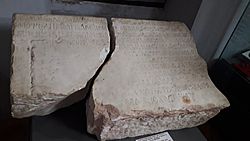
There is another idea about Samuel's background. The 11th-century historian Stepanos Asoghik wrote that Samuel had only one brother. He said they were both Armenians from the district of Derjan. This was an Armenian land that became part of the Byzantine Empire. They were sent to fight the Bulgarians in Macedonia. But they ended up joining the Bulgarians. This idea is supported by historian Nicholas Adontz. He studied the events and concluded that Samuel had only one brother, David. Asoghik's idea is also supported by historian Jordan Ivanov. Also, only one brother is mentioned on Samuel's Inscription.
The Arab historian Yahya of Antioch says that Samuel's son, Gavril, was killed by Aaron's son. He said this was because Aaron belonged to the family that ruled Bulgaria. Asoghik and Yahya clearly say that Samuel's family was different from Aaron's family. They say the Cometopuli family was different from the royal family. According to them, Moses and Aaron were not from the Cometopuli family. David and Samuel were of Armenian origin. Moses and Aaron were Armenian on their mother's side.
Samuel's grave was found in 1965 by Greek professor Nikolaos Moutsopoulos. It was in the Church of St Achillios on the island of the same name in Lake Prespa. Samuel had built the church for the holy items of the saint. What is thought to be the coat of arms of the Cometopuli family, two perched parrots, was embroidered on his funeral clothing.
His remains are kept in the Museum of Byzantine Culture in Thessaloniki. But a recent agreement suggests they might be returned to Bulgaria. They could be buried in the SS. Forty Martyrs Church in Veliko Tarnovo. There, they would rest with the remains of Emperors Kaloyan and Michael Shishman.
Samuel's face was reconstructed to show what the 70-year-old Bulgarian ruler looked like. The reconstruction shows he was a man with a sharp face, bald, with a white beard and mustache.
Samuel is one of the most famous Bulgarian rulers. His military struggles with the Byzantine Empire are seen as a heroic time in Bulgarian history. Many monuments and memorials in Bulgaria and North Macedonia, like those in Petrich and Ohrid, show how important this historical figure is to people's memories. Four Bulgarian villages are named after him, as well as Samuel Point on Livingston Island, Antarctica. Samuel is the main character in at least three major Bulgarian novels by authors Dimitar Talev, Anton Donchev, and Stefan Tsanev. He also stars in the Greek novel "At the Times of the Bulgarian-Slayer" by Penelope Delta. He is mentioned in poems by Ivan Vazov, Pencho Slaveykov, and Atanas Dalchev.
Who Was Samuel? (Nomenclature)
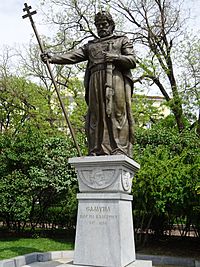

Samuel's empire was centered in the modern region of Macedonia. This was west and southwest of the city of Ohrid. This area was an important cultural center of the First Bulgarian Empire. After 1913, following five centuries of Ottoman rule, the area was taken by the Kingdom of Serbia (later Yugoslavia). This led to some historians claiming Samuel's empire was a "Serbian" or "Macedonian Slavic" state, separate from the Bulgarian Empire. More recently, the same idea has been kept alive in North Macedonia.
However, in Samuel's time, "Macedonia" as a geographical term referred to part of the region of modern Thrace. The "Macedonian" emperors of that period were Basil II, called "Bulgar-Slayer", and his Byzantine relatives from the Macedonian dynasty. They came from the territory of today's European Turkey. Most of the modern region of Macedonia was then a Bulgarian province known as Kutmichevitsa. The area became part of the Byzantine Empire in 1018 as a new province called Bulgaria.
The name "Macedonia" for the modern region was only brought back in the 1800s. Before the early 1900s, most Macedonian Slavs believed they were Bulgarians. The Balkan Wars (1912–1913) and World War I (1914–1918) divided the area mainly between Greece and Serbia. This changed who lived there. The Bulgarian community became smaller, either by people moving or by changing their ethnic identity. The Macedonian Slavs faced a policy of forced Serbianisation.
Modern historians generally agree that Samuel and his successors considered their state Bulgarian. They were never called "Macedonians" by people at the time. They were simply called Bulgarians and sometimes Misians. The last name came from the fact that Bulgaria then controlled the lands of the old Roman province of Moesia. Despite these facts, there have been many disagreements between Bulgaria and North Macedonia about Samuel's ethnic background. This issue is still very sensitive.
In June 2017, the Prime Ministers of Bulgaria and North Macedonia, Boyko Borisov and Zoran Zaev, laid flowers at Tsar Samuel's monument together. They hoped to solve their issues by signing a good-neighbor agreement. They signed the friendship treaty that year, and both parliaments approved it in 2018. Based on this, a group of experts on historical issues was formed. In February 2019, this group agreed to suggest that Tsar Samuel be celebrated jointly. The Macedonian side also agreed that he was Tsar of Bulgaria. However, in December 2020, North Macedonia's part of the group changed its mind. They said Tsar Samuel should be shown one way in North Macedonia's textbooks and another way during joint celebrations.
In August 2022, North Macedonia's Ministry of Foreign Affairs published official advice from the Joint Historical Commission. They suggested that the governments in Sofia and Skopje should jointly remember Samuel. According to the commission, he was the ruler of a large medieval state. Most modern historians agree this state was the Bulgarian empire itself, centered in what is now North Macedonia. This way, the Macedonian members of the Commission agreed that Samuel's state was Bulgarian. They also recognized that Bulgarian people existed during the Middle Ages.
See also
 In Spanish: Samuel de Bulgaria para niños
In Spanish: Samuel de Bulgaria para niños
- Byzantine-Bulgarian Wars
- Bulgarian-Hungarian Wars
- Croatian-Bulgarian Wars
- Medieval Bulgarian Army
- Cometopuli dynasty
- Bitola inscription
- Samuil's Inscription
- Armenians in Bulgaria


